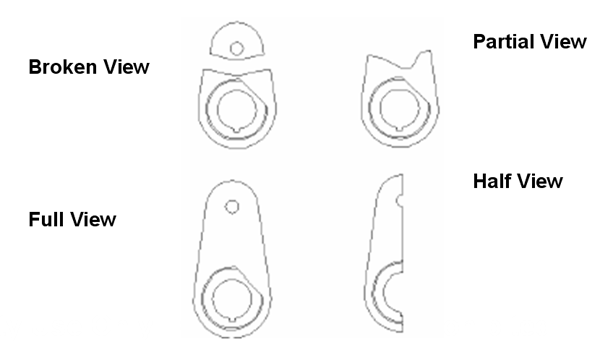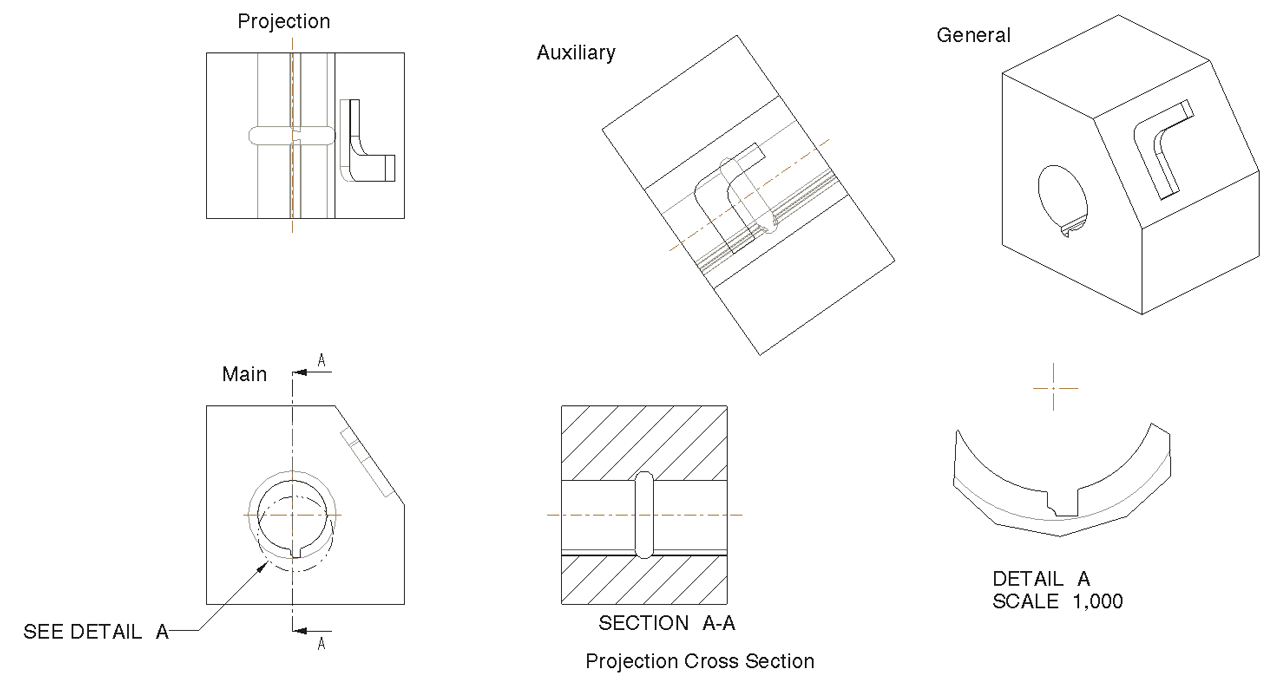Break from orthographic view. Half sections or views.
Last Updated on Sat 23 Oct 2021 Engineering Drawing.
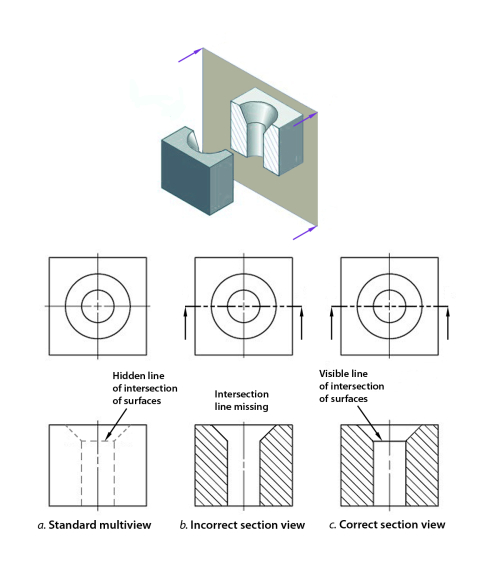
. The cutting-plane line cuts halfway through the part and removes one quarter of the material. A simple bracket is shown in Fig. Break line is a thin continuous line and is drawn freehand.
Concept example A section view is made by revolving the cross-section view 90 o about a cutting plane line and drawn on the orthographic view. The diagonal lines on the section drawing are used to indicate the area that has been theoretically cut. A few of the more common ones are.
DISPLACEMENT OF HOLES IN SECTION ciralar in out-ting at pitch from in raffer 32 Drawing sectional views In orthogonal to complete of an ng Intemally of a The of C line to Nhlch it The of a lire type A. Section lines are thin lines. In this type of section only half of the space or object is cut away.
This is the most common section called a full section with the imaginary laser cutting a line across. The lines are thin and are usually drawn. Dimensioning to dotted lines is not a recommended practice.
Here is an object sectioned from two different directions. A cutting plane does not necessarily need to cut the whole object. A section is used to show the detail of a component or an assembly on a particular plane which is known as the cutting plane.
You select the orientation of the view when you create it. These lines are called section lining or cross-hatching. There are a number of different types of sectional views that can be drawn.
Figure 20 - Front view and half section. You can create one or more base views on a drawing sheet. Section lines are used to indicate where the cutting plane cuts the material.
Symmetrical parts may be drawn half in section and half in outside view. The main difference between isometric and typical perspective drawings is that in the latter the lines recede to vanishing points. Section line symbols are chosen according to the material of the object Section lines are generally drawn at a 45 angle.
Full section The view obtained even the cutting plane is right across the object. Sectional views in engineering technical drawings Half Sectional views. The base view is the source for subsequent views and controls the scale and alignment for them.
Revolved section. - इजनयरग डरइग म सकशन क परकर 1. A half-section is a view of an object showing one-half of the view in section as in figure 19 and 20.
Plan Section and Elevation are different types of drawings used by architects to graphically represent a building design and construction. In this view the cutting plane is assumed to bend at a right angle and cuts through only half of the. Full section in a full section the cutting plane line passes fully through the part.
There is no cutting plane line. When specific features of an object that need highlighting are not located. An Elevation drawing is drawn on a vertical plane showing a vertical depiction.
What is Half Section. Lines Used in Section Views ¾Section Lines. A section drawing is a view taken after you slice an object then look at the surface created by the slicing.
The line that separates the different types interior and exterior may be a. Base View The first view created in a drawing. REVOLVED SECTION VIEW Revolved sections show cross-sectional features of a part.
Full sections half sections broken sections rotated. There are three major types of sections used in engineering drawing. A cutting plane line shows where object was cut to obtain the section view.
The default orientations are based on the origin in the digital prototype. Broken crosshatching shows where cutting plane line intersections material each material has its own crosshatching cutting plane line shows where the imaginery knife cuts thru the part line is always parallel to a line of rotation shows which cutting plane line goes to the section. What is Full Section.
FIGURE PART OR LOCAL SECTIONS Part at a to detail of type u normal the maln m drawings in this THE FULL SECTIONAL VIEW the d FIGURE 310. Normally a view is replaced with the full section view. In both cases the object should be standing on its base when the.
Types of section views 1. There are three major types of sections used in engineering drawing. Half sections are commonly used to show both the internal and outside view of symmetrical objects.
Types of Section in Engineering Drawing. Partial or Broken Out Section 4. 6 Types of sectional views Full sections.
A full section is the most widely-used sectional view. BROKEN-OUT SECTION VIEW A break line is used to separate the sectioned portion from the unsectioned portion of the view. Placement of a cross-section view 31.
A revolving view is effective for elongated objects or. No need for additional orthographic views. 81 and it is required to draw three sectional viewsAssume that you had a bracket and cut it with a hacksaw along the line marked B-B.
This type of drawing avoids the necessity of introducing dotted lines for the holes and the recess. K half section The view Obtained When the cutting plane goes half way across the Object to the centre line. Figure 19 - Full and sectioned isometric views.
Example a a b b 30. An area cross section displays only the cross section without the geometry. A plan drawing is a drawing on a horizontal plane showing a view from above.
You have learned that when making a multiview sketch hidden edges and surfaces are usually shown with hidden dash lines. An aligned cross section displays an area cross-sectional view that is unfolded around an axis whereas a total aligned cross section shows an aligned cross section of a. Projected View An orthographic or isometric.
Half Section is used to the exterior and interior of the part in the same view. Superimposed to orthographic view. Types of Sectional Views Full Section.
An elevation drawing is a view taken from a point outside the object without any slicing. The three main types of pictorial drawings that are extensively used in architectural presentations are perspective drawings isometric drawings and oblique drawings.

Design Handbook Engineering Drawing And Sketching Related Resources Design And Manufacturing I Mechanical Engineering Mit Opencourseware
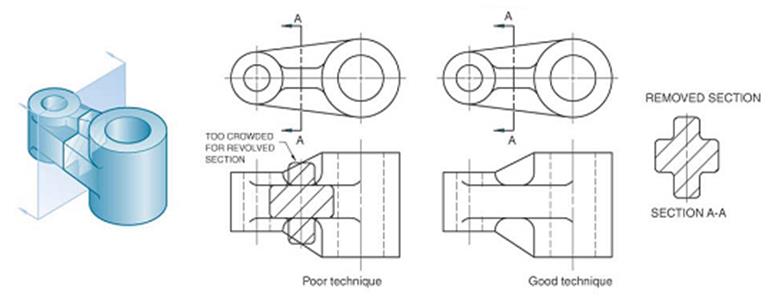
Sectional Views In Engineering Technical Drawings

Sectioning Technique Engineering Design Mcgill University
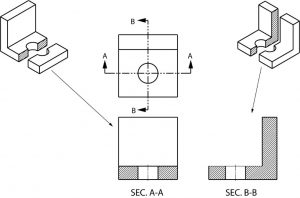
Sectional Views Basic Blueprint Reading
